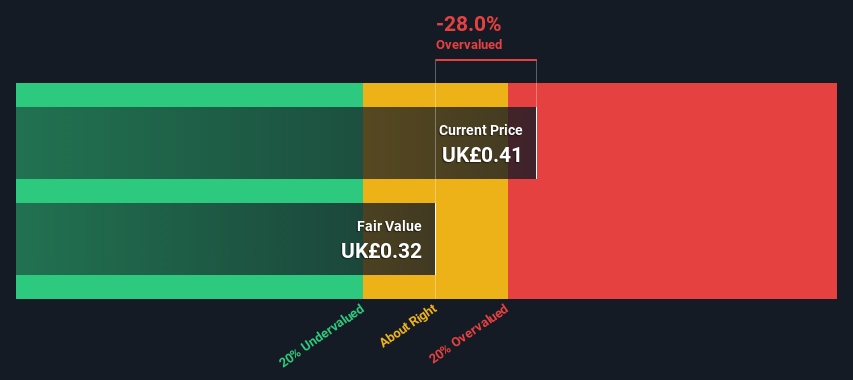Empresaria Group plc (LON:EMR) shares could be 28% above their estimated intrinsic value

Key findings
-
Using the 2-step Free Cash Flow to Equity, the estimated fair value of Empresaria Group is 0.32 GBP
-
Empresaria Group’s share price of 0.41 GBP suggests the company could be overvalued by 28%
-
Compared to the industry average discount of -10%, Empresaria Group’s competitors appear to be trading at a smaller premium to fair value.
Today we’re going to walk through one way to estimate the intrinsic value of Empresaria Group plc (LON:EMR) by taking the company’s forecast future cash flows and discounting them to today’s value. One way to do this is to apply the discounted cash flow (DCF) model. Before you think you can’t understand it, just read on! It’s actually a lot less complex than you think.
Companies can be valued in many ways, so we want to point out that a DCF is not perfect for every situation. If you want to learn more about discounted cash flow, you can read the basics of this calculation in detail in Simply Wall St’s analysis model.
Check out our latest analysis for Empresaria Group
Processing the numbers
We use a two-stage DCF model which, as the name suggests, considers two phases of growth. The first stage is generally a higher growth phase that stabilizes toward the terminal value, which is captured in the second “steady growth” stage. The first stage requires us to estimate the company’s cash flows for the next ten years. Since we don’t have analyst estimates of free cash flow available, we extrapolated the previous free cash flow (FCF) from the company’s last reported value. We assume that companies with shrinking free cash flow will slow their rate of shrinkage and that companies with growing free cash flow will slow their growth rate over this period. We do this to account for the fact that growth tends to slow more in the early years than in later years.
A DCF is all about the idea that a dollar in the future is worth less than a dollar today. Therefore, we need to discount the sum of these future cash flows to arrive at an estimate of present value:
Estimation of free cash flow (FCF) over 10 years
|
2025 |
2026 |
2027 |
2028 |
2029 |
2030 |
2031 |
2032 |
2033 |
2034 |
|
|
Leveraged FCF (£, million) |
£2.57 million |
£1.99m |
£1.69 million |
£1.52 million |
£1.42 million |
£1.37 million |
£1.33 million |
£1.32 million |
£1.32 million |
£1.32 million |
|
Source of growth rate estimate |
Estimated @ -32.66% |
Estimated @ -22.33% |
Estimated @ -15.10% |
Estimated @ -10.04% |
Estimated @ -6.50% |
Estimated @ -4.02% |
Estimated @ -2.28% |
Estimated -1.07% |
Estimated -0.21% |
Estimated 0.38% |
|
Present value (£, million) discounted at 11% |
2.3 euros |
1.6 euros |
1.2 euros |
1.0 EUR |
0.9 EUR |
0.7 EUR |
0.7 EUR |
0.6 EUR |
0,50 € |
0,50 € |
(“Est” = FCF growth rate, estimated by Simply Wall St)
Present value of 10-year cash flow (PVCF) = £10 million
After calculating the present value of future cash flows in the first 10-year period, we need to calculate the terminal value, which takes into account all future cash flows after the first period. For various reasons, a very conservative growth rate is used, which cannot exceed a country’s GDP growth. In this case, we used the 5-year average of the 10-year government bond yield (1.8%) to estimate future growth. In the same way as with the 10-year “growth” period, we discount future cash flows to today’s value, using a cost of equity of 11%.
Final value (TV)= FCF2034 × (1 + g) ÷ (r – g) = £1.3 million × (1 + 1.8%) ÷ (11% – 1.8%) = £15 million
Present value of terminal value (PVTV)= TV / (1 + r)10= £15 million ÷ (1 + 11%)10= £5.5 million
The total value or equity value is then the sum of the present value of future cash flows, which in this case is £16m. To get the intrinsic value per share, we divide this by the total number of shares in issue. Compared to the current share price of £0.4, the company appears slightly overvalued at the time of writing. However, keep in mind that this is only an approximate valuation and as with any complex formula, where rubbish goes in, rubbish comes out.


Important assumptions
The above calculation relies heavily on two assumptions. The first is the discount rate and the other is the cash flows. If you disagree with these results, try the calculation yourself and play with the assumptions. DCF also does not take into account the possible cyclicality of an industry or a company’s future capital needs and therefore does not provide a complete picture of a company’s potential performance. Since we consider Empresaria Group as potential shareholders, the cost of equity is used as the discount rate rather than the cost of capital (or weighted average cost of capital, WACC) which takes debt into account. In this calculation, we used 11%, which is based on a leveraged beta of 1.628. Beta is a measure of a stock’s volatility relative to the overall market. We get our beta from the industry average beta of globally comparable companies with an imposed limit of between 0.8 and 2.0, which is a reasonable range for a stable company.
SWOT analysis for Empresaria Group
Strength
weakness
Opportunity
Danger
Go on:
Valuation is only one side of the coin when building your investment thesis and should not be the only metric you consider when researching a company. The DCF model is not a perfect tool for stock valuation. Rather, it should be viewed as a guide to “what assumptions must hold for this stock to be under/overvalued.” For example, changes in the company’s cost of equity or risk-free interest rate can significantly affect valuation. Why is the intrinsic value lower than the current share price? For Empresaria Group, we have compiled three basic factors for you to consider:
-
Risks: Take risks, for example – Empresaria Group has 3 warning signs (and 1, which is important) that we think you should know about.
-
management:Have insiders increased their shares to capitalize on market sentiment regarding EMR’s future prospects? Read our management and board analysis with insights into CEO compensation and governance factors.
-
Other high-quality alternatives: Do you like a good all-rounder? Explore our interactive list of high-quality stocks to get an idea of what else you might be missing out on!
PS Simply Wall St updates its DCF calculation for each UK stock daily, so if you want to find out the intrinsic value of another stock, just search here.
Do you have feedback on this article? Are you concerned about the content? Get in touch directly from us. Alternatively, send an email to editorial-team (at) simplywallst.com.
This Simply Wall St article is of a general nature. We comment solely on the basis of historical data and analyst forecasts, using an unbiased methodology. Our articles do not constitute financial advice. It is not a recommendation to buy or sell any stock and does not take into account your objectives or financial situation. Our goal is to provide you with long-term analysis based on fundamental data. Note that our analysis may not take into account the latest price-sensitive company announcements or qualitative materials. Simply Wall St does not hold any of the stocks mentioned.
Do you have feedback on this article? Are you interested in the content? Contact us directly. Alternatively, send an email to [email protected]



